Individual Essay: Risks of Low Wage Growth in the Australian Economy
VerifiedAdded on 2021/05/30
|9
|2055
|28
Essay
AI Summary
This essay provides a macroeconomic analysis of the risks associated with slow wage growth in the Australian economy. It begins with an introduction referencing the IMF's concerns about weak wage growth and below-target inflation. The essay then discusses the declining wage rate growth in the Australian labor market, using data and the wage price index (WPI) to support its arguments. It explores the risks of low wage growth through three key theories: the relationship between wage rate growth and productivity, the impact of wage growth on investment and demand, and the connection between wage rate growth and inflation. The analysis also touches upon the impact of declining terms of trade and the need for structural analysis to understand wage outcomes. The conclusion reiterates the challenges posed by slow wage growth and the need to monitor factors influencing wage adjustments, especially in relation to the mining sector, labor market conditions, and inflation expectations. Appendices containing relevant data are also included to support the analysis.
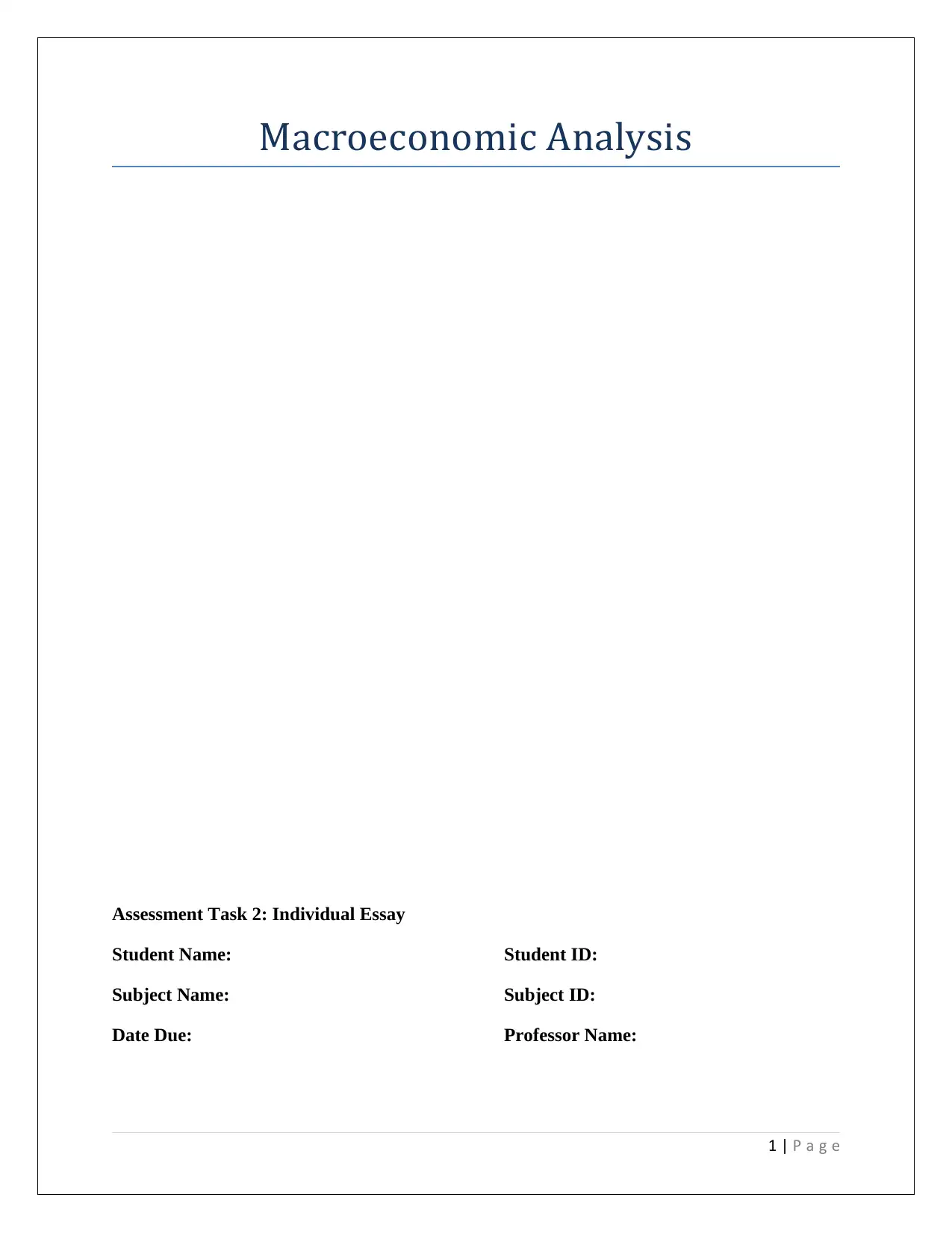
Macroeconomic Analysis
Assessment Task 2: Individual Essay
Student Name: Student ID:
Subject Name: Subject ID:
Date Due: Professor Name:
1 | P a g e
Assessment Task 2: Individual Essay
Student Name: Student ID:
Subject Name: Subject ID:
Date Due: Professor Name:
1 | P a g e
Paraphrase This Document
Need a fresh take? Get an instant paraphrase of this document with our AI Paraphraser
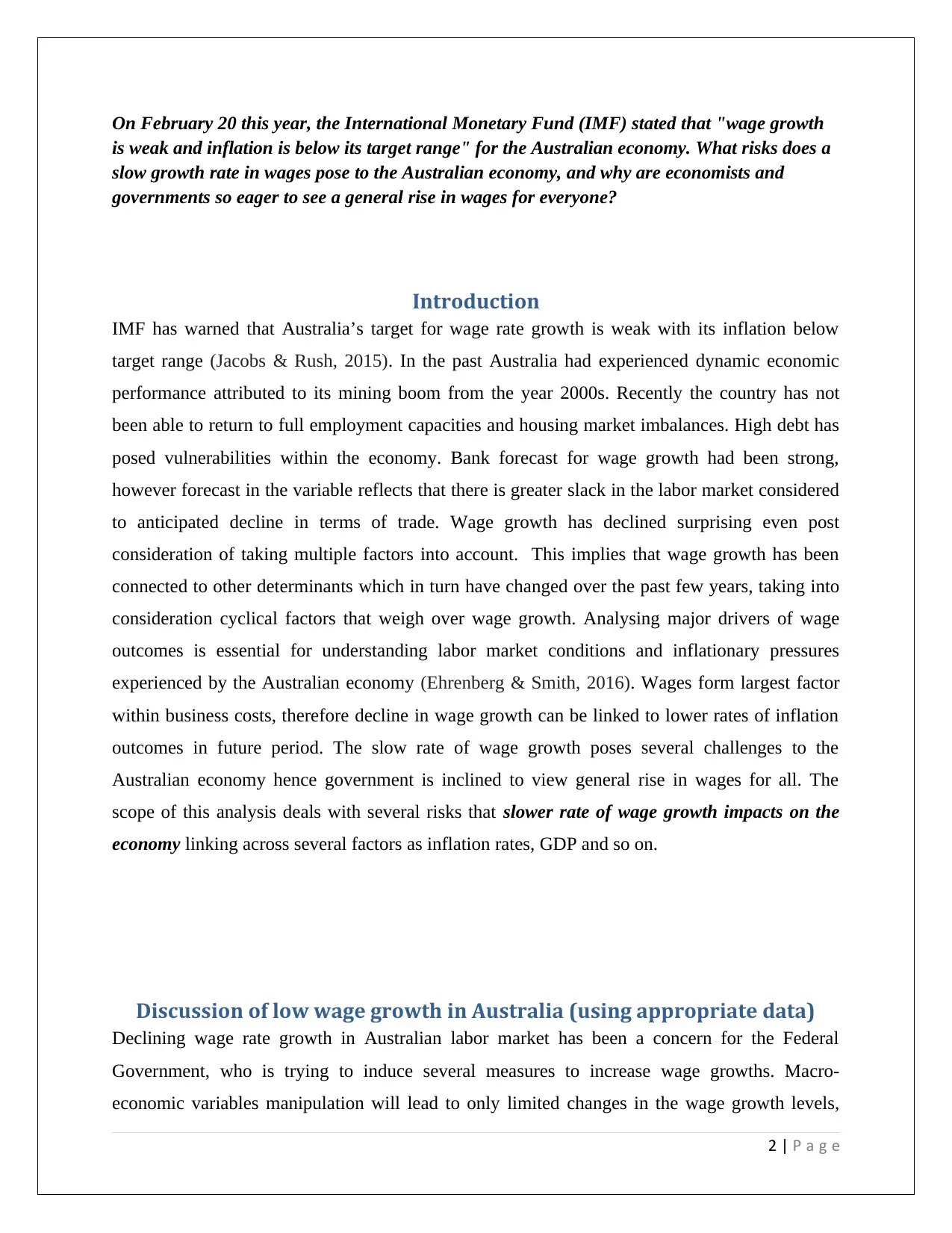
On February 20 this year, the International Monetary Fund (IMF) stated that "wage growth
is weak and inflation is below its target range" for the Australian economy. What risks does a
slow growth rate in wages pose to the Australian economy, and why are economists and
governments so eager to see a general rise in wages for everyone?
Introduction
IMF has warned that Australia’s target for wage rate growth is weak with its inflation below
target range (Jacobs & Rush, 2015). In the past Australia had experienced dynamic economic
performance attributed to its mining boom from the year 2000s. Recently the country has not
been able to return to full employment capacities and housing market imbalances. High debt has
posed vulnerabilities within the economy. Bank forecast for wage growth had been strong,
however forecast in the variable reflects that there is greater slack in the labor market considered
to anticipated decline in terms of trade. Wage growth has declined surprising even post
consideration of taking multiple factors into account. This implies that wage growth has been
connected to other determinants which in turn have changed over the past few years, taking into
consideration cyclical factors that weigh over wage growth. Analysing major drivers of wage
outcomes is essential for understanding labor market conditions and inflationary pressures
experienced by the Australian economy (Ehrenberg & Smith, 2016). Wages form largest factor
within business costs, therefore decline in wage growth can be linked to lower rates of inflation
outcomes in future period. The slow rate of wage growth poses several challenges to the
Australian economy hence government is inclined to view general rise in wages for all. The
scope of this analysis deals with several risks that slower rate of wage growth impacts on the
economy linking across several factors as inflation rates, GDP and so on.
Discussion of low wage growth in Australia (using appropriate data)
Declining wage rate growth in Australian labor market has been a concern for the Federal
Government, who is trying to induce several measures to increase wage growths. Macro-
economic variables manipulation will lead to only limited changes in the wage growth levels,
2 | P a g e
is weak and inflation is below its target range" for the Australian economy. What risks does a
slow growth rate in wages pose to the Australian economy, and why are economists and
governments so eager to see a general rise in wages for everyone?
Introduction
IMF has warned that Australia’s target for wage rate growth is weak with its inflation below
target range (Jacobs & Rush, 2015). In the past Australia had experienced dynamic economic
performance attributed to its mining boom from the year 2000s. Recently the country has not
been able to return to full employment capacities and housing market imbalances. High debt has
posed vulnerabilities within the economy. Bank forecast for wage growth had been strong,
however forecast in the variable reflects that there is greater slack in the labor market considered
to anticipated decline in terms of trade. Wage growth has declined surprising even post
consideration of taking multiple factors into account. This implies that wage growth has been
connected to other determinants which in turn have changed over the past few years, taking into
consideration cyclical factors that weigh over wage growth. Analysing major drivers of wage
outcomes is essential for understanding labor market conditions and inflationary pressures
experienced by the Australian economy (Ehrenberg & Smith, 2016). Wages form largest factor
within business costs, therefore decline in wage growth can be linked to lower rates of inflation
outcomes in future period. The slow rate of wage growth poses several challenges to the
Australian economy hence government is inclined to view general rise in wages for all. The
scope of this analysis deals with several risks that slower rate of wage growth impacts on the
economy linking across several factors as inflation rates, GDP and so on.
Discussion of low wage growth in Australia (using appropriate data)
Declining wage rate growth in Australian labor market has been a concern for the Federal
Government, who is trying to induce several measures to increase wage growths. Macro-
economic variables manipulation will lead to only limited changes in the wage growth levels,
2 | P a g e
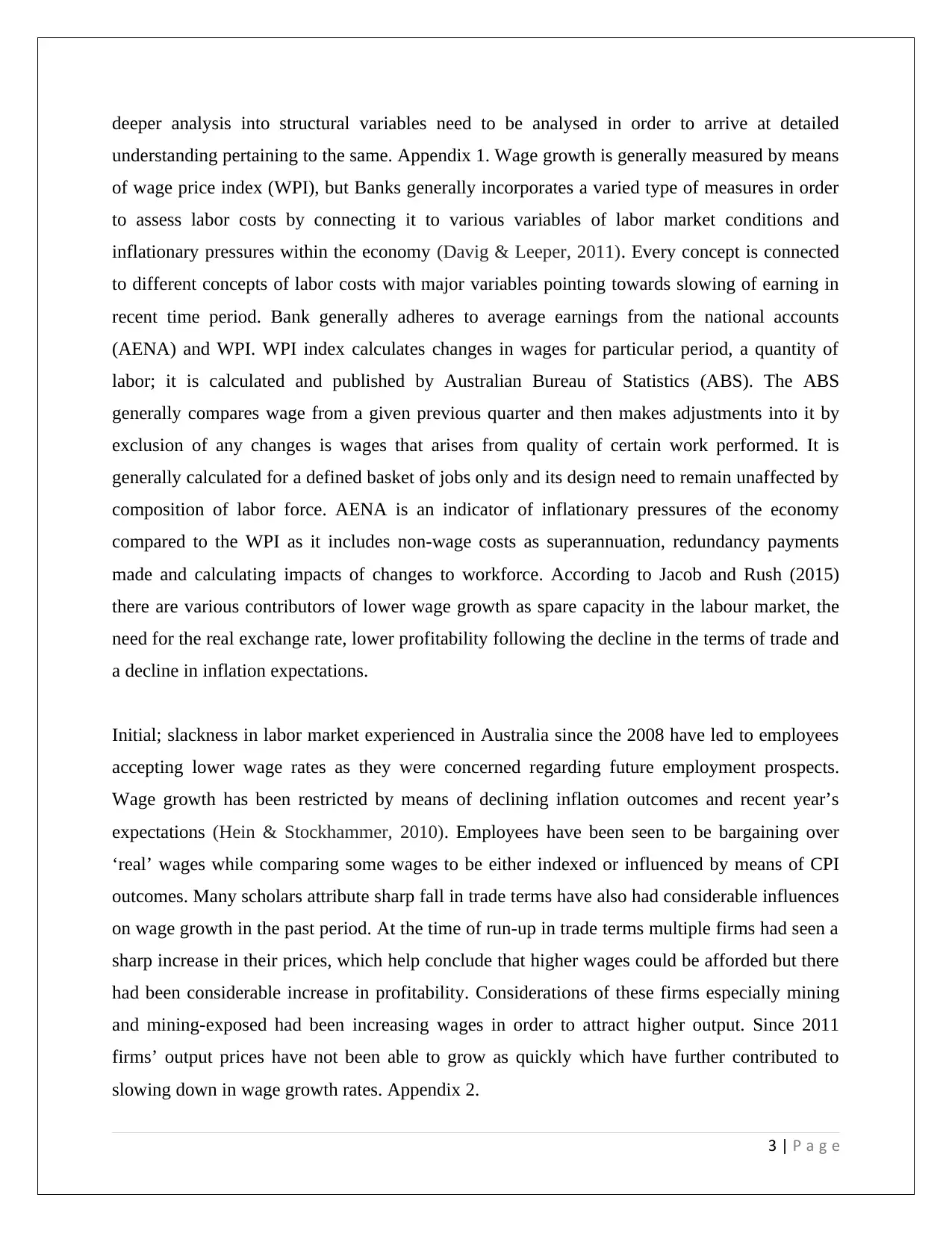
deeper analysis into structural variables need to be analysed in order to arrive at detailed
understanding pertaining to the same. Appendix 1. Wage growth is generally measured by means
of wage price index (WPI), but Banks generally incorporates a varied type of measures in order
to assess labor costs by connecting it to various variables of labor market conditions and
inflationary pressures within the economy (Davig & Leeper, 2011). Every concept is connected
to different concepts of labor costs with major variables pointing towards slowing of earning in
recent time period. Bank generally adheres to average earnings from the national accounts
(AENA) and WPI. WPI index calculates changes in wages for particular period, a quantity of
labor; it is calculated and published by Australian Bureau of Statistics (ABS). The ABS
generally compares wage from a given previous quarter and then makes adjustments into it by
exclusion of any changes is wages that arises from quality of certain work performed. It is
generally calculated for a defined basket of jobs only and its design need to remain unaffected by
composition of labor force. AENA is an indicator of inflationary pressures of the economy
compared to the WPI as it includes non-wage costs as superannuation, redundancy payments
made and calculating impacts of changes to workforce. According to Jacob and Rush (2015)
there are various contributors of lower wage growth as spare capacity in the labour market, the
need for the real exchange rate, lower profitability following the decline in the terms of trade and
a decline in inflation expectations.
Initial; slackness in labor market experienced in Australia since the 2008 have led to employees
accepting lower wage rates as they were concerned regarding future employment prospects.
Wage growth has been restricted by means of declining inflation outcomes and recent year’s
expectations (Hein & Stockhammer, 2010). Employees have been seen to be bargaining over
‘real’ wages while comparing some wages to be either indexed or influenced by means of CPI
outcomes. Many scholars attribute sharp fall in trade terms have also had considerable influences
on wage growth in the past period. At the time of run-up in trade terms multiple firms had seen a
sharp increase in their prices, which help conclude that higher wages could be afforded but there
had been considerable increase in profitability. Considerations of these firms especially mining
and mining-exposed had been increasing wages in order to attract higher output. Since 2011
firms’ output prices have not been able to grow as quickly which have further contributed to
slowing down in wage growth rates. Appendix 2.
3 | P a g e
understanding pertaining to the same. Appendix 1. Wage growth is generally measured by means
of wage price index (WPI), but Banks generally incorporates a varied type of measures in order
to assess labor costs by connecting it to various variables of labor market conditions and
inflationary pressures within the economy (Davig & Leeper, 2011). Every concept is connected
to different concepts of labor costs with major variables pointing towards slowing of earning in
recent time period. Bank generally adheres to average earnings from the national accounts
(AENA) and WPI. WPI index calculates changes in wages for particular period, a quantity of
labor; it is calculated and published by Australian Bureau of Statistics (ABS). The ABS
generally compares wage from a given previous quarter and then makes adjustments into it by
exclusion of any changes is wages that arises from quality of certain work performed. It is
generally calculated for a defined basket of jobs only and its design need to remain unaffected by
composition of labor force. AENA is an indicator of inflationary pressures of the economy
compared to the WPI as it includes non-wage costs as superannuation, redundancy payments
made and calculating impacts of changes to workforce. According to Jacob and Rush (2015)
there are various contributors of lower wage growth as spare capacity in the labour market, the
need for the real exchange rate, lower profitability following the decline in the terms of trade and
a decline in inflation expectations.
Initial; slackness in labor market experienced in Australia since the 2008 have led to employees
accepting lower wage rates as they were concerned regarding future employment prospects.
Wage growth has been restricted by means of declining inflation outcomes and recent year’s
expectations (Hein & Stockhammer, 2010). Employees have been seen to be bargaining over
‘real’ wages while comparing some wages to be either indexed or influenced by means of CPI
outcomes. Many scholars attribute sharp fall in trade terms have also had considerable influences
on wage growth in the past period. At the time of run-up in trade terms multiple firms had seen a
sharp increase in their prices, which help conclude that higher wages could be afforded but there
had been considerable increase in profitability. Considerations of these firms especially mining
and mining-exposed had been increasing wages in order to attract higher output. Since 2011
firms’ output prices have not been able to grow as quickly which have further contributed to
slowing down in wage growth rates. Appendix 2.
3 | P a g e
⊘ This is a preview!⊘
Do you want full access?
Subscribe today to unlock all pages.

Trusted by 1+ million students worldwide
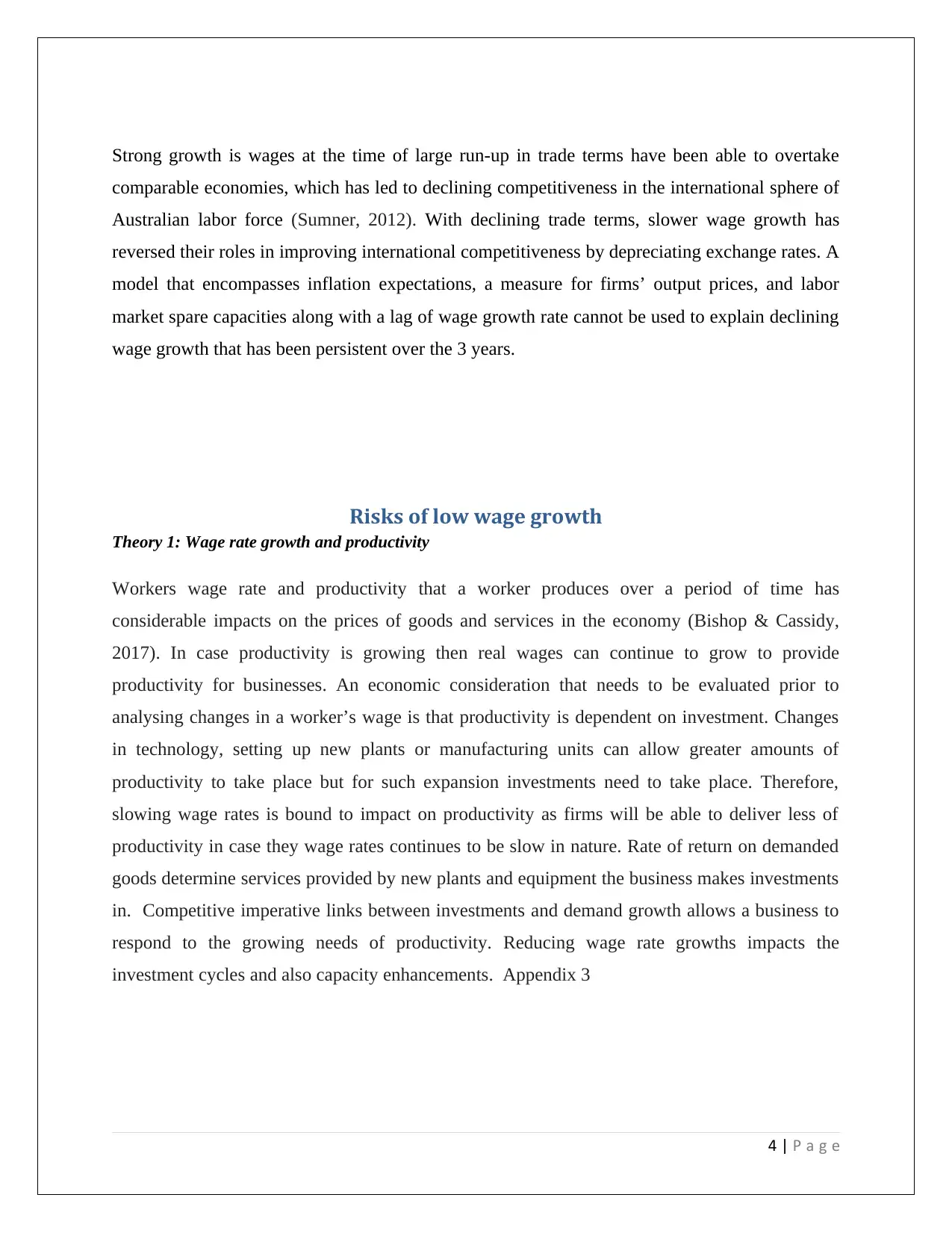
Strong growth is wages at the time of large run-up in trade terms have been able to overtake
comparable economies, which has led to declining competitiveness in the international sphere of
Australian labor force (Sumner, 2012). With declining trade terms, slower wage growth has
reversed their roles in improving international competitiveness by depreciating exchange rates. A
model that encompasses inflation expectations, a measure for firms’ output prices, and labor
market spare capacities along with a lag of wage growth rate cannot be used to explain declining
wage growth that has been persistent over the 3 years.
Risks of low wage growth
Theory 1: Wage rate growth and productivity
Workers wage rate and productivity that a worker produces over a period of time has
considerable impacts on the prices of goods and services in the economy (Bishop & Cassidy,
2017). In case productivity is growing then real wages can continue to grow to provide
productivity for businesses. An economic consideration that needs to be evaluated prior to
analysing changes in a worker’s wage is that productivity is dependent on investment. Changes
in technology, setting up new plants or manufacturing units can allow greater amounts of
productivity to take place but for such expansion investments need to take place. Therefore,
slowing wage rates is bound to impact on productivity as firms will be able to deliver less of
productivity in case they wage rates continues to be slow in nature. Rate of return on demanded
goods determine services provided by new plants and equipment the business makes investments
in. Competitive imperative links between investments and demand growth allows a business to
respond to the growing needs of productivity. Reducing wage rate growths impacts the
investment cycles and also capacity enhancements. Appendix 3
4 | P a g e
comparable economies, which has led to declining competitiveness in the international sphere of
Australian labor force (Sumner, 2012). With declining trade terms, slower wage growth has
reversed their roles in improving international competitiveness by depreciating exchange rates. A
model that encompasses inflation expectations, a measure for firms’ output prices, and labor
market spare capacities along with a lag of wage growth rate cannot be used to explain declining
wage growth that has been persistent over the 3 years.
Risks of low wage growth
Theory 1: Wage rate growth and productivity
Workers wage rate and productivity that a worker produces over a period of time has
considerable impacts on the prices of goods and services in the economy (Bishop & Cassidy,
2017). In case productivity is growing then real wages can continue to grow to provide
productivity for businesses. An economic consideration that needs to be evaluated prior to
analysing changes in a worker’s wage is that productivity is dependent on investment. Changes
in technology, setting up new plants or manufacturing units can allow greater amounts of
productivity to take place but for such expansion investments need to take place. Therefore,
slowing wage rates is bound to impact on productivity as firms will be able to deliver less of
productivity in case they wage rates continues to be slow in nature. Rate of return on demanded
goods determine services provided by new plants and equipment the business makes investments
in. Competitive imperative links between investments and demand growth allows a business to
respond to the growing needs of productivity. Reducing wage rate growths impacts the
investment cycles and also capacity enhancements. Appendix 3
4 | P a g e
Paraphrase This Document
Need a fresh take? Get an instant paraphrase of this document with our AI Paraphraser
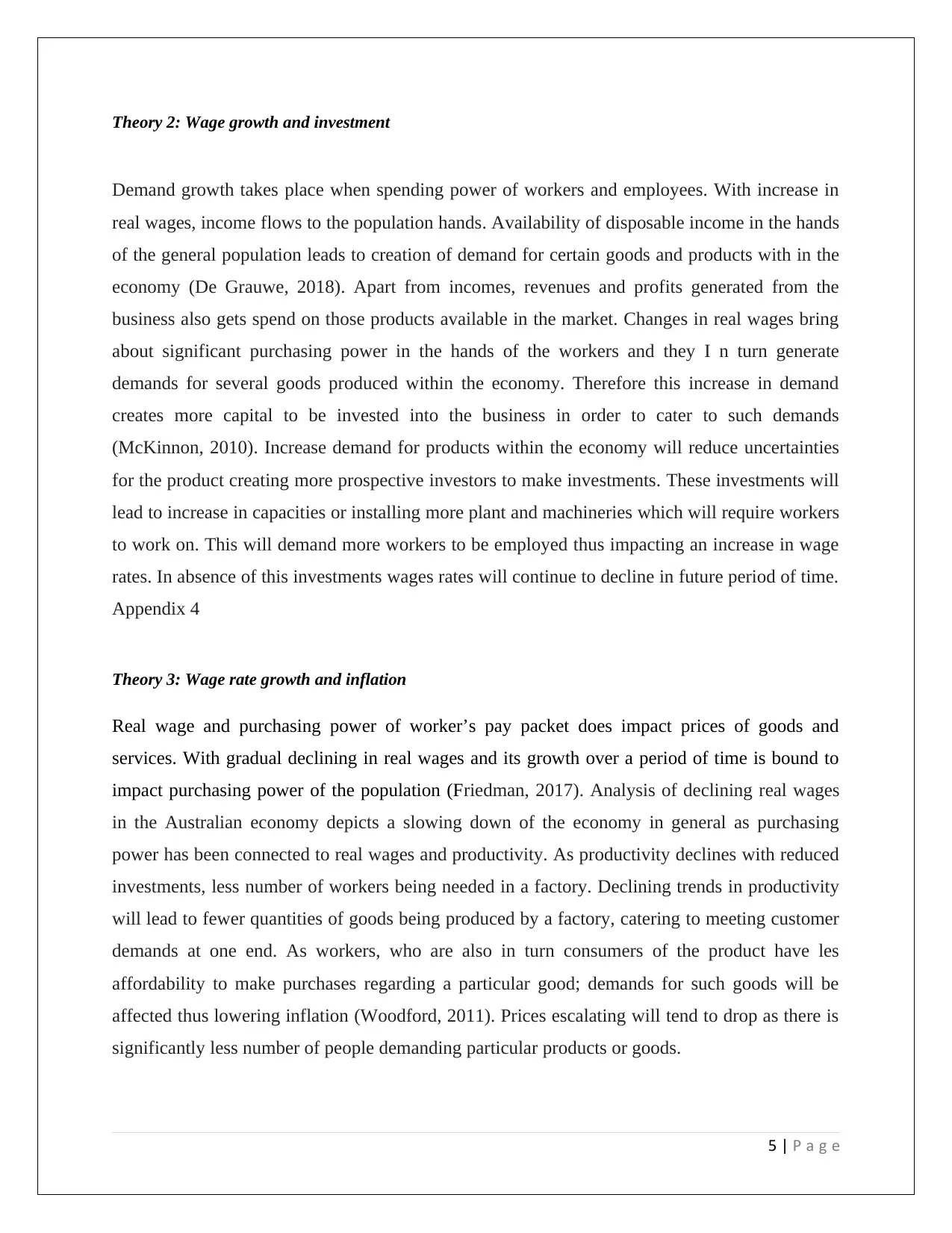
Theory 2: Wage growth and investment
Demand growth takes place when spending power of workers and employees. With increase in
real wages, income flows to the population hands. Availability of disposable income in the hands
of the general population leads to creation of demand for certain goods and products with in the
economy (De Grauwe, 2018). Apart from incomes, revenues and profits generated from the
business also gets spend on those products available in the market. Changes in real wages bring
about significant purchasing power in the hands of the workers and they I n turn generate
demands for several goods produced within the economy. Therefore this increase in demand
creates more capital to be invested into the business in order to cater to such demands
(McKinnon, 2010). Increase demand for products within the economy will reduce uncertainties
for the product creating more prospective investors to make investments. These investments will
lead to increase in capacities or installing more plant and machineries which will require workers
to work on. This will demand more workers to be employed thus impacting an increase in wage
rates. In absence of this investments wages rates will continue to decline in future period of time.
Appendix 4
Theory 3: Wage rate growth and inflation
Real wage and purchasing power of worker’s pay packet does impact prices of goods and
services. With gradual declining in real wages and its growth over a period of time is bound to
impact purchasing power of the population (Friedman, 2017). Analysis of declining real wages
in the Australian economy depicts a slowing down of the economy in general as purchasing
power has been connected to real wages and productivity. As productivity declines with reduced
investments, less number of workers being needed in a factory. Declining trends in productivity
will lead to fewer quantities of goods being produced by a factory, catering to meeting customer
demands at one end. As workers, who are also in turn consumers of the product have les
affordability to make purchases regarding a particular good; demands for such goods will be
affected thus lowering inflation (Woodford, 2011). Prices escalating will tend to drop as there is
significantly less number of people demanding particular products or goods.
5 | P a g e
Demand growth takes place when spending power of workers and employees. With increase in
real wages, income flows to the population hands. Availability of disposable income in the hands
of the general population leads to creation of demand for certain goods and products with in the
economy (De Grauwe, 2018). Apart from incomes, revenues and profits generated from the
business also gets spend on those products available in the market. Changes in real wages bring
about significant purchasing power in the hands of the workers and they I n turn generate
demands for several goods produced within the economy. Therefore this increase in demand
creates more capital to be invested into the business in order to cater to such demands
(McKinnon, 2010). Increase demand for products within the economy will reduce uncertainties
for the product creating more prospective investors to make investments. These investments will
lead to increase in capacities or installing more plant and machineries which will require workers
to work on. This will demand more workers to be employed thus impacting an increase in wage
rates. In absence of this investments wages rates will continue to decline in future period of time.
Appendix 4
Theory 3: Wage rate growth and inflation
Real wage and purchasing power of worker’s pay packet does impact prices of goods and
services. With gradual declining in real wages and its growth over a period of time is bound to
impact purchasing power of the population (Friedman, 2017). Analysis of declining real wages
in the Australian economy depicts a slowing down of the economy in general as purchasing
power has been connected to real wages and productivity. As productivity declines with reduced
investments, less number of workers being needed in a factory. Declining trends in productivity
will lead to fewer quantities of goods being produced by a factory, catering to meeting customer
demands at one end. As workers, who are also in turn consumers of the product have les
affordability to make purchases regarding a particular good; demands for such goods will be
affected thus lowering inflation (Woodford, 2011). Prices escalating will tend to drop as there is
significantly less number of people demanding particular products or goods.
5 | P a g e
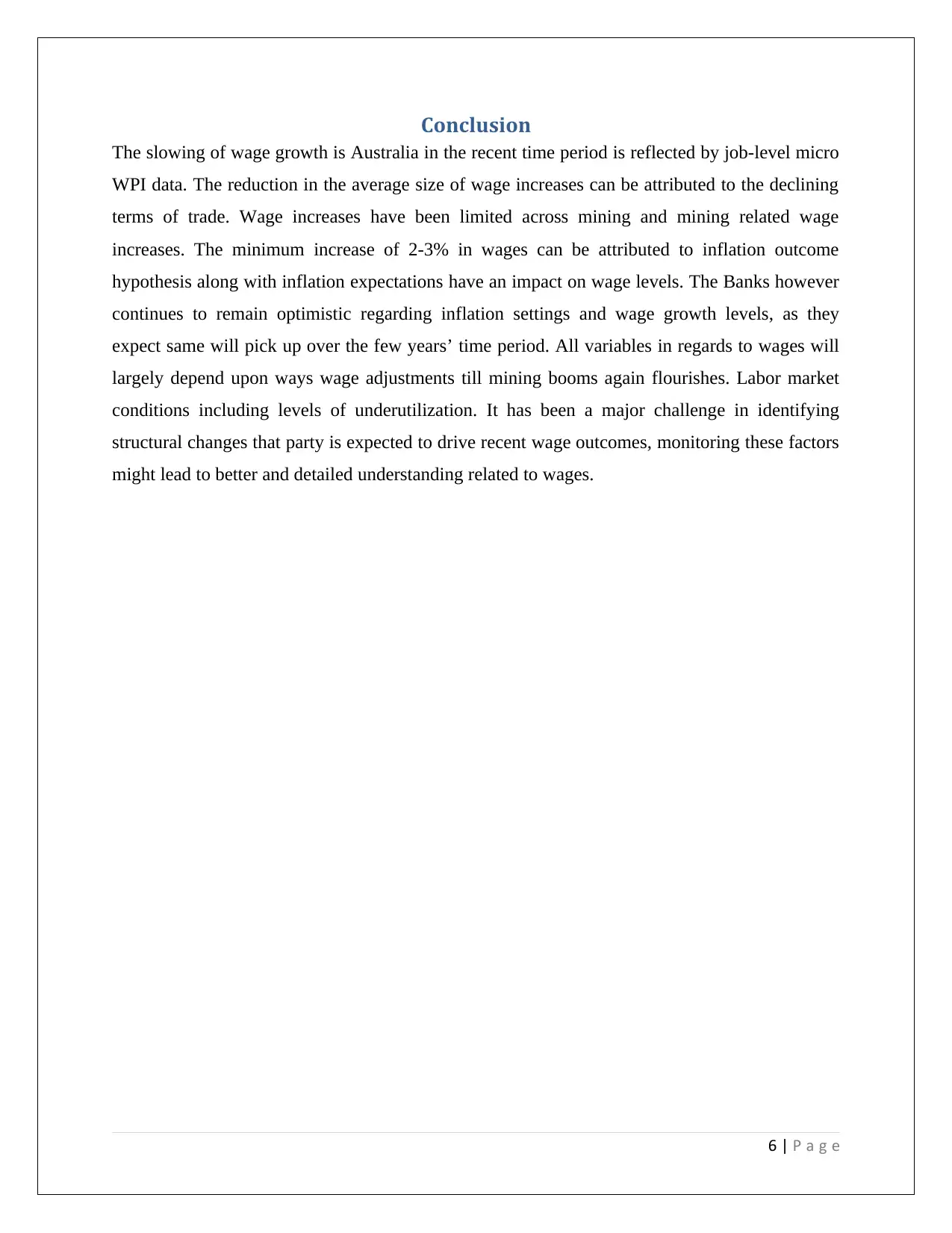
Conclusion
The slowing of wage growth is Australia in the recent time period is reflected by job-level micro
WPI data. The reduction in the average size of wage increases can be attributed to the declining
terms of trade. Wage increases have been limited across mining and mining related wage
increases. The minimum increase of 2-3% in wages can be attributed to inflation outcome
hypothesis along with inflation expectations have an impact on wage levels. The Banks however
continues to remain optimistic regarding inflation settings and wage growth levels, as they
expect same will pick up over the few years’ time period. All variables in regards to wages will
largely depend upon ways wage adjustments till mining booms again flourishes. Labor market
conditions including levels of underutilization. It has been a major challenge in identifying
structural changes that party is expected to drive recent wage outcomes, monitoring these factors
might lead to better and detailed understanding related to wages.
6 | P a g e
The slowing of wage growth is Australia in the recent time period is reflected by job-level micro
WPI data. The reduction in the average size of wage increases can be attributed to the declining
terms of trade. Wage increases have been limited across mining and mining related wage
increases. The minimum increase of 2-3% in wages can be attributed to inflation outcome
hypothesis along with inflation expectations have an impact on wage levels. The Banks however
continues to remain optimistic regarding inflation settings and wage growth levels, as they
expect same will pick up over the few years’ time period. All variables in regards to wages will
largely depend upon ways wage adjustments till mining booms again flourishes. Labor market
conditions including levels of underutilization. It has been a major challenge in identifying
structural changes that party is expected to drive recent wage outcomes, monitoring these factors
might lead to better and detailed understanding related to wages.
6 | P a g e
⊘ This is a preview!⊘
Do you want full access?
Subscribe today to unlock all pages.

Trusted by 1+ million students worldwide
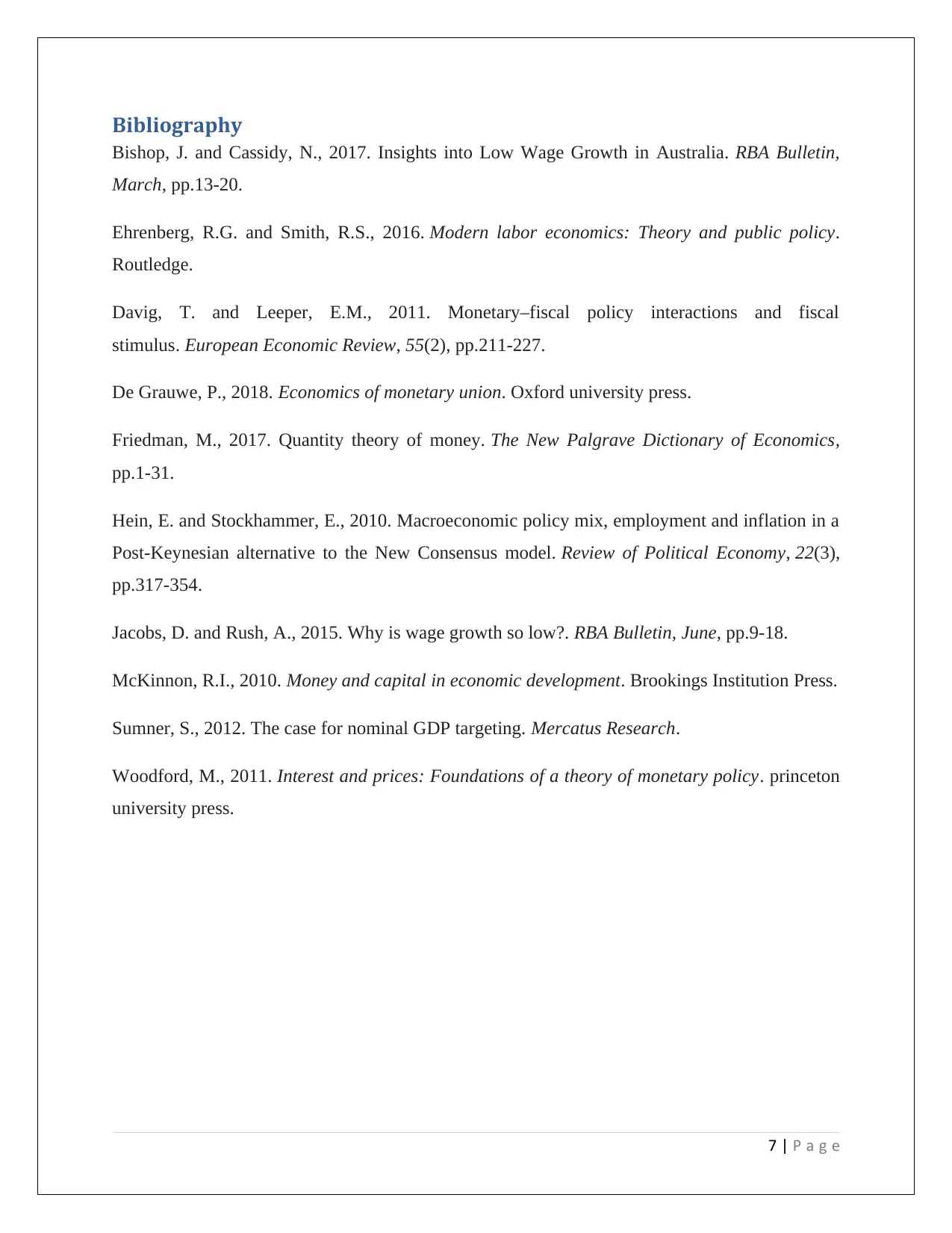
Bibliography
Bishop, J. and Cassidy, N., 2017. Insights into Low Wage Growth in Australia. RBA Bulletin,
March, pp.13-20.
Ehrenberg, R.G. and Smith, R.S., 2016. Modern labor economics: Theory and public policy.
Routledge.
Davig, T. and Leeper, E.M., 2011. Monetary–fiscal policy interactions and fiscal
stimulus. European Economic Review, 55(2), pp.211-227.
De Grauwe, P., 2018. Economics of monetary union. Oxford university press.
Friedman, M., 2017. Quantity theory of money. The New Palgrave Dictionary of Economics,
pp.1-31.
Hein, E. and Stockhammer, E., 2010. Macroeconomic policy mix, employment and inflation in a
Post-Keynesian alternative to the New Consensus model. Review of Political Economy, 22(3),
pp.317-354.
Jacobs, D. and Rush, A., 2015. Why is wage growth so low?. RBA Bulletin, June, pp.9-18.
McKinnon, R.I., 2010. Money and capital in economic development. Brookings Institution Press.
Sumner, S., 2012. The case for nominal GDP targeting. Mercatus Research.
Woodford, M., 2011. Interest and prices: Foundations of a theory of monetary policy. princeton
university press.
7 | P a g e
Bishop, J. and Cassidy, N., 2017. Insights into Low Wage Growth in Australia. RBA Bulletin,
March, pp.13-20.
Ehrenberg, R.G. and Smith, R.S., 2016. Modern labor economics: Theory and public policy.
Routledge.
Davig, T. and Leeper, E.M., 2011. Monetary–fiscal policy interactions and fiscal
stimulus. European Economic Review, 55(2), pp.211-227.
De Grauwe, P., 2018. Economics of monetary union. Oxford university press.
Friedman, M., 2017. Quantity theory of money. The New Palgrave Dictionary of Economics,
pp.1-31.
Hein, E. and Stockhammer, E., 2010. Macroeconomic policy mix, employment and inflation in a
Post-Keynesian alternative to the New Consensus model. Review of Political Economy, 22(3),
pp.317-354.
Jacobs, D. and Rush, A., 2015. Why is wage growth so low?. RBA Bulletin, June, pp.9-18.
McKinnon, R.I., 2010. Money and capital in economic development. Brookings Institution Press.
Sumner, S., 2012. The case for nominal GDP targeting. Mercatus Research.
Woodford, M., 2011. Interest and prices: Foundations of a theory of monetary policy. princeton
university press.
7 | P a g e
Paraphrase This Document
Need a fresh take? Get an instant paraphrase of this document with our AI Paraphraser
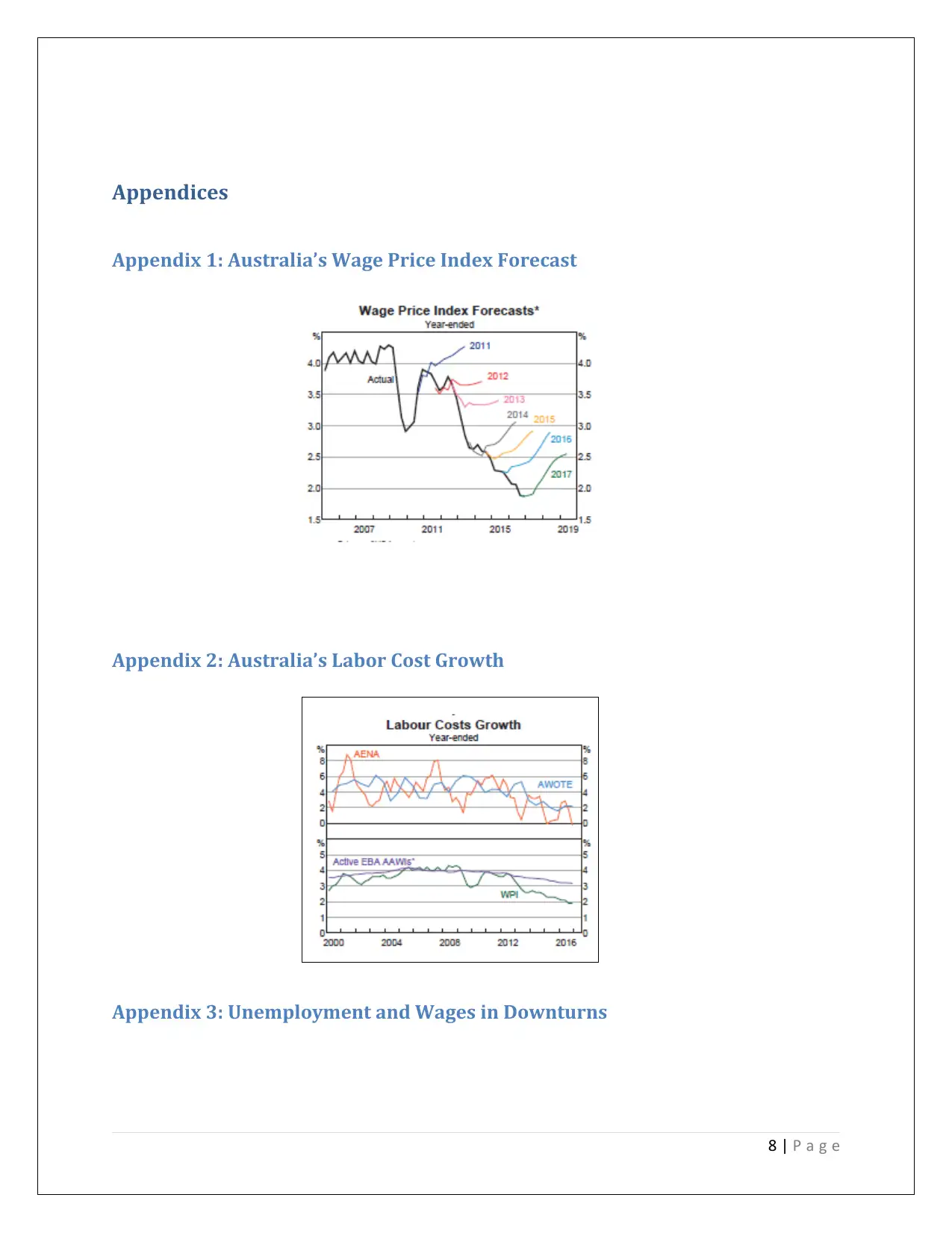
Appendices
Appendix 1: Australia’s Wage Price Index Forecast
Appendix 2: Australia’s Labor Cost Growth
Appendix 3: Unemployment and Wages in Downturns
8 | P a g e
Appendix 1: Australia’s Wage Price Index Forecast
Appendix 2: Australia’s Labor Cost Growth
Appendix 3: Unemployment and Wages in Downturns
8 | P a g e
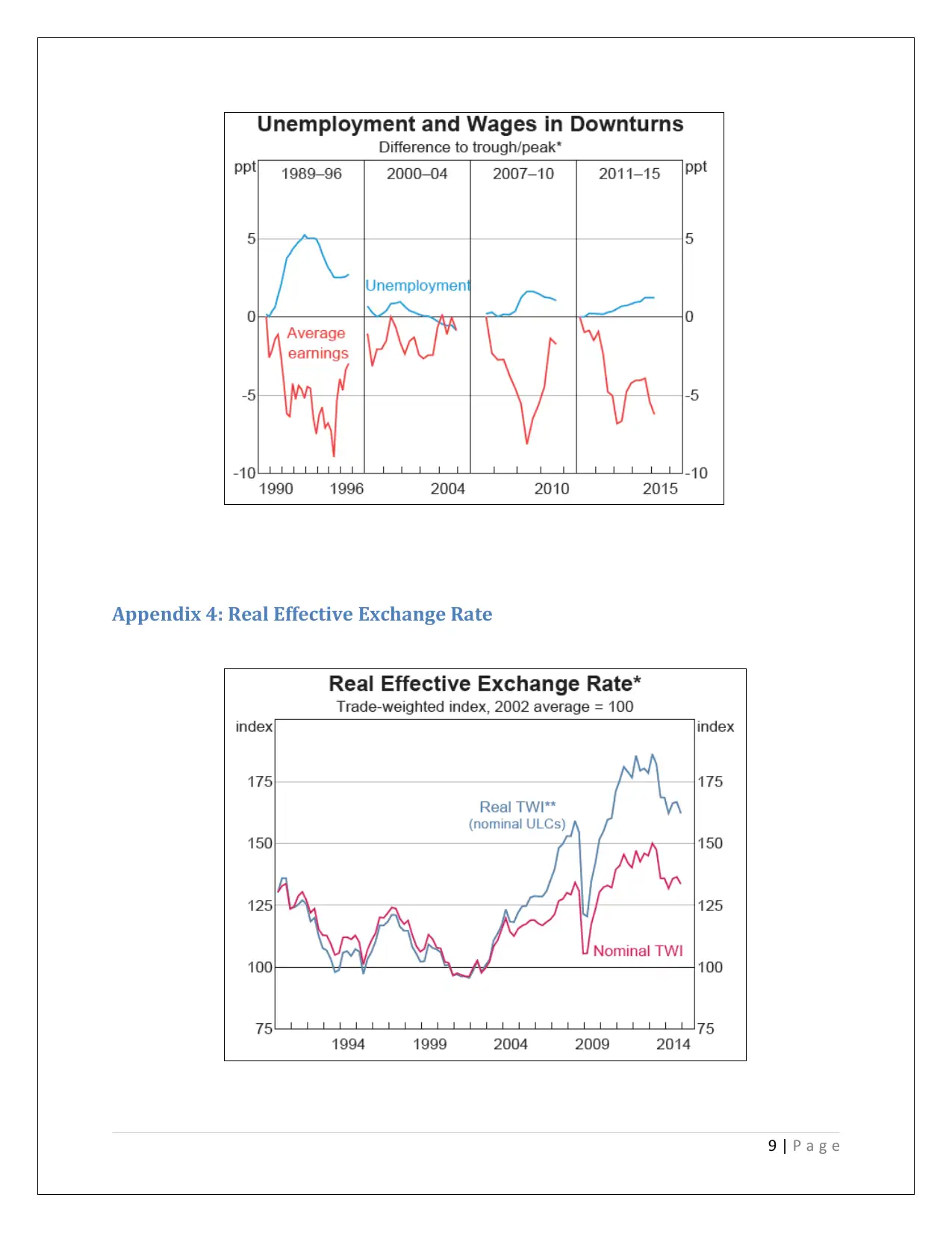
Appendix 4: Real Effective Exchange Rate
9 | P a g e
9 | P a g e
⊘ This is a preview!⊘
Do you want full access?
Subscribe today to unlock all pages.

Trusted by 1+ million students worldwide
1 out of 9
Related Documents
Your All-in-One AI-Powered Toolkit for Academic Success.
+13062052269
info@desklib.com
Available 24*7 on WhatsApp / Email
![[object Object]](/_next/static/media/star-bottom.7253800d.svg)
Unlock your academic potential
Copyright © 2020–2025 A2Z Services. All Rights Reserved. Developed and managed by ZUCOL.





